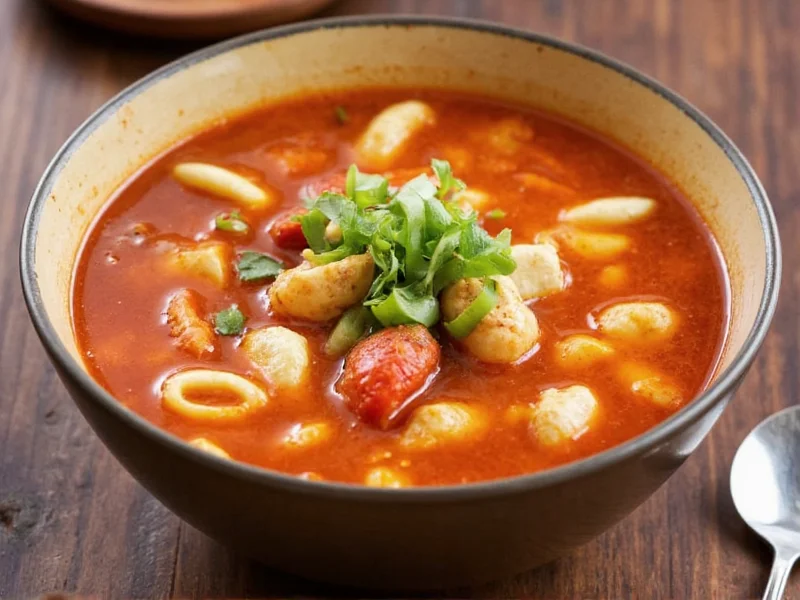Nothing captures the essence of Thai cuisine quite like a steaming bowl of authentic tom yum soup. This iconic dish delivers an exhilarating dance of flavors—fiery chilies, tangy lime, aromatic herbs, and savory broth—that has made it a global favorite. Unlike Westernized versions that often include coconut milk, traditional tom yum features a clear broth that showcases the vibrant interplay of Thai ingredients.
The Origins of Thailand's Signature Soup
Tom yum originated in central Thailand, where its bold flavors perfectly complement the region's cuisine. The name comes from two Thai words: "tom" meaning to boil, and "yum" referring to a spicy and sour salad. This culinary marriage creates a soup that's simultaneously refreshing and invigorating. Historically, tom yum was prepared with whatever freshwater shrimp or fish were available, making it both accessible and adaptable across Thailand's diverse regions.
Essential Ingredients for Authentic Flavor
The magic of tom yum lies in its distinctive herb and spice combination. While substitutions exist, authentic tom yum requires these key components:
| Core Ingredient | Authentic Purpose | Substitution Notes |
|---|---|---|
| Lemongrass | Provides citrusy aroma and subtle sweetness | Use 2-3 stalks, bruised and cut into 2-inch pieces |
| Kaffir lime leaves | Unique floral-citrus fragrance essential to authenticity | Never omit; frozen works if fresh unavailable |
| Galangal | Earthy, pine-like flavor distinct from ginger | Not interchangeable with ginger; find in Asian markets |
| Fresh Thai chilies | Provides authentic heat (bird's eye chilies preferred) | Adjust quantity based on desired spice level |
| Fish sauce | Savory umami base (use premium Thai brands) | Soy sauce makes it inauthentic; vegetarian alternative available |
Traditional Tom Yum vs. Westernized Versions
Understanding the difference between authentic tom yum and restaurant-style versions is crucial for making an authentic tom yum soup recipe. Traditional tom yum features a clear broth that highlights the interplay of herbs and spices. The "tom yum nam sai" (clear soup) version contains no coconut milk, while "tom yum nam khon" includes a small amount of coconut cream for richness. Many Western restaurants serve the creamy version exclusively, but true Thai connoisseurs prefer the lighter, more aromatic clear broth that showcases each ingredient's distinct character.
Step-by-Step Preparation Guide
Follow these steps for easy tom yum soup from scratch that captures Thailand's culinary spirit:
Ingredients for 4 servings
- 4 cups (1L) good quality chicken or vegetable broth
- 2 stalks lemongrass, bruised and cut into 2-inch pieces
- 5-6 kaffir lime leaves, torn
- 3-4 slices galangal (about 1/4 inch thick)
- 2-4 fresh Thai chilies, bruised
- 8 oz (225g) shrimp, peeled and deveined (or chicken/thinly sliced mushrooms)
- 4 oz (115g) straw mushrooms or oyster mushrooms
- 3 tbsp lime juice (about 1.5 limes)
- 2-3 tbsp fish sauce (to taste)
- 1 tsp palm sugar (optional)
- 2 tbsp cilantro, chopped
Preparation Steps
- Bring broth to a gentle simmer in a medium pot.
- Add lemongrass, kaffir lime leaves, galangal, and chilies. Simmer for 10 minutes to infuse flavors.
- Add mushrooms and protein (shrimp/chicken). Cook until protein is nearly done (3-4 minutes for shrimp).
- Remove from heat and stir in lime juice, fish sauce, and palm sugar. Never boil after adding lime juice as it becomes bitter.
- Taste and adjust seasoning—balance should be spicy, sour, and salty with subtle sweetness.
- Garnish with fresh cilantro and serve immediately with jasmine rice.
Perfecting Your Tom Yum: Pro Tips
Mastering how to make traditional tom yum requires attention to detail:
- Bruise herbs: Smash lemongrass and chilies with the back of your knife to release essential oils
- Layer flavors: Add ingredients in sequence—aromatics first, acid last
- Balance is key: Adjust lime juice and fish sauce incrementally until flavors sing in harmony
- Freshness matters: Use fresh lime juice, not bottled, for authentic bright flavor
- Don't overcook: Remove from heat before adding citrus to preserve vibrant notes
Common Variations to Explore
Once you've mastered the tom yum goong recipe with shrimp, experiment with these authentic variations:
- Tom Yum Talay: Seafood version with mixed shellfish
- Tom Yum Gai: Chicken-based version (use bone-in pieces for richer broth)
- Tom Yum Nam Khon: Creamy version with 1/4 cup coconut milk added at the end
- Vegetarian Tom Yum: Substitute vegetable broth and use soy sauce instead of fish sauce
Troubleshooting Common Issues
Even experienced cooks encounter challenges with homemade tom yum soup steps. Here's how to fix common problems:
- Too sour: Add a pinch of sugar or more broth to balance
- Not spicy enough: Add fresh chilies or a dash of chili oil
- Bland flavor: Simmer aromatics longer or add more fish sauce
- Muddy broth: Strain broth through cheesecloth before serving
- Overpowering fish sauce: Add more lime juice to cut through
Serving and Storage Recommendations
For the most authentic experience, serve tom yum immediately after preparation while the aromas are vibrant. Pair with steamed jasmine rice to balance the intense flavors. Leftovers can be stored in an airtight container for up to 2 days, though the shrimp (if used) is best fresh. When reheating, add a splash of water as the soup thickens when chilled. Never freeze tom yum as the delicate flavor balance deteriorates.
Why This Recipe Works
This spicy Thai soup recipe succeeds by honoring traditional preparation methods while making authentic ingredients accessible. The careful sequencing of ingredients preserves each component's unique contribution to the final flavor profile. Unlike many online recipes that take shortcuts, this method ensures the complex interplay of spicy, sour, salty, and sweet notes that defines exceptional tom yum. The best tom yum soup ingredients work synergistically when treated with respect—galangal's earthiness grounds the citrus notes, while fish sauce provides umami depth without overwhelming the delicate herb profile.











 浙公网安备
33010002000092号
浙公网安备
33010002000092号 浙B2-20120091-4
浙B2-20120091-4